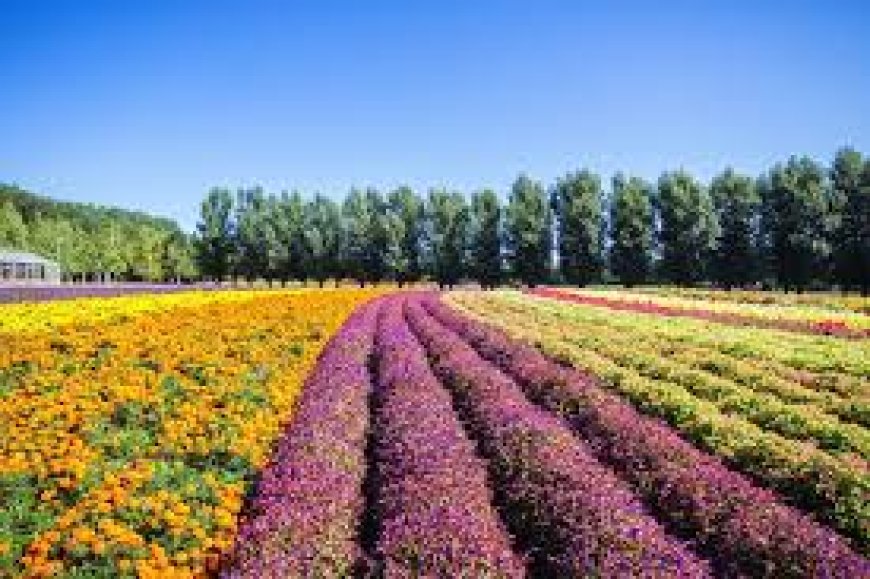Exploring the Diverse Types of Floriculture Practiced in India

Floriculture, the art and science of cultivating flowers, has been an integral part of India's agricultural landscape for centuries. With its diverse climate, rich soil, and skilled labor force, India offers a conducive environment for a wide variety of floriculture practices. From traditional methods passed down through generations to modern, high-tech greenhouse facilities, the country boasts a range of techniques and specialties. In this article, we delve into the fascinating world of floriculture in India, exploring its types, significance, challenges, and future prospects.
-
Traditional Floriculture:
- In many rural areas of India, traditional methods of floriculture have been practiced for generations.
- Small-scale cultivation of flowers like marigold, jasmine, rose, and chrysanthemum is common in home gardens and small farms.
- These flowers hold cultural and religious significance and are used in various ceremonies, festivals, and rituals across the country.
- Traditional floriculture often involves organic farming practices and minimal use of chemical inputs.
-
Cut Flower Cultivation:
- Cut flower cultivation is a significant segment of India's floriculture industry, catering primarily to domestic and export markets.
- Roses, gerberas, carnations, and lilies are some of the popular flowers grown for their ornamental value and long vase life.
- States like Karnataka, Tamil Nadu, Maharashtra, and West Bengal are known for their extensive cut flower cultivation, supported by favorable climatic conditions and infrastructure.
-
Loose Flower Cultivation:
- Loose flowers, also known as open-pollinated flowers, are those sold without stems or foliage.
- Flowers like marigold, jasmine, tuberose, and crossandra are cultivated extensively for their use in garlands, religious offerings, and decorations.
- Loose flower cultivation is prevalent in states like Andhra Pradesh, Telangana, Kerala, and Uttar Pradesh, where they are an essential part of local culture and traditions.
-
Bulbous Flower Cultivation:
- Bulbous flowers, which grow from bulbs or corms, have gained popularity in recent years due to their unique shapes, colors, and fragrances.
- Flowers such as gladiolus, tulips, daffodils, and iris are cultivated in specific regions with suitable soil and climate conditions.
- Bulbous flower cultivation requires careful planning, soil preparation, and post-harvest handling to ensure quality and longevity.
-
Orchid Cultivation:
- Orchids, known for their exotic beauty and diversity, have emerged as a high-value crop in India's floriculture sector.
- With over 1,300 species of orchids found in the country, India offers immense potential for orchid cultivation.
- States like Sikkim, Arunachal Pradesh, Kerala, and parts of the Northeastern region are ideal for orchid cultivation due to their cool, moist climates and high humidity levels.
- Orchid cultivation requires specialized knowledge, infrastructure, and management practices to thrive.
-
Greenhouse Floriculture:
- Greenhouse floriculture involves the cultivation of flowers in controlled environments, providing optimal conditions for growth and productivity.
- High-tech greenhouses equipped with climate control systems, irrigation facilities, and nutrient management systems are becoming increasingly popular in India.
- Greenhouse cultivation allows year-round production, higher yields, and better quality flowers, meeting the demands of both domestic and international markets.
- Flowers like gerberas, carnations, and roses are commonly grown in greenhouse facilities across the country.
Significance of Floriculture in India:
- Floriculture plays a crucial role in India's economy, providing employment opportunities, generating income for farmers, and contributing to foreign exchange earnings through exports.
- The industry also supports ancillary sectors such as packaging, transportation, and marketing, creating a ripple effect on the economy.
- Flowers have cultural, social, and religious significance in Indian society, being used in weddings, festivals, religious ceremonies, and other celebrations.
- Floriculture promotes environmental sustainability by encouraging biodiversity, conserving water resources, and reducing carbon emissions through green practices.
Challenges and Future Prospects:
- Despite its growth potential, the floriculture industry in India faces various challenges such as inadequate infrastructure, lack of access to technology and credit facilities, post-harvest losses, and stiff competition from global markets.
- Addressing these challenges requires concerted efforts from the government, industry stakeholders, and farmers to improve infrastructure, provide technical support, and promote market linkages.
- With increasing urbanization, rising incomes, and changing consumer preferences, the demand for high-quality flowers is expected to rise, presenting opportunities for expansion and diversification in the floriculture sector.
- Embracing modern technologies such as precision farming, drip irrigation, tissue culture propagation, and value addition can enhance productivity, quality, and competitiveness in the floriculture industry.
In conclusion, floriculture in India is a vibrant and dynamic sector with a rich cultural heritage and immense growth potential. By harnessing its natural resources, traditional knowledge, and technological innovations, India can emerge as a global leader in floriculture, contributing to economic development, environmental sustainability, and cultural enrichment. As the country marches towards a blooming future, the fragrant petals of floriculture continue to adorn its landscape, symbolizing beauty, prosperity, and harmony.







